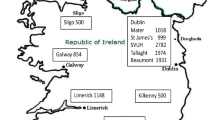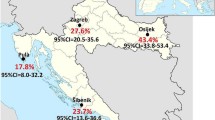Abstract
The prevalence of serologic markers for hepatitis A was investigated in 936 French male military recruits from October 1992 to June 1993. Data were collected in order to assess the evolution of seroprevalence level according to the decline observed for several years and to appreciate the importance of potential risk factors. The overall prevalence of antibody against hepatitis A virus was 16.3%. The prevalence was higher among those with high number of siblings and whose Father's occuption falls into low professional class categories. Multivariate analysis found that high level of seroprevalence was also associated with tap water consumption (odd ratio (OR)=1.56;p<0.04), overseas travels (OR=2.26;p<0.001) and was higher for recruits reporting an history of clinical jaundice (OR=2.27;p<0.01). Together with more anticipated factors, tap water consumption may be of importance in France and this study points out the potential part taken by chlorinated water.
Similar content being viewed by others
References
Szmuness W, Dienstag JL, Purcell RH, et al. The prevalence of antibody to hepatitis A antigen in various parts of the world: a pilot study. Am J Epidemiol 1977; 106: 392–398.
Frösner GG, Papaevangelou G, Bütler R, et al. Antibody against hepatitis A in seven european countries: comparison of prevalence data in different age groups. Am J Epidemiol 1979; 110: 63–69.
Papaevangelou G, Gourgouli, KP, Visoulis HG. Epidemiologic characteristics of hepatitis A virus infection in Greece. Am J Epidemiol 1980; 112: 482–486.
Papaevangelou G. Epidemiology of hepatitis A in Mediterranean countries. Vaccines 1992; 10 (suppl 1): S63-S66.
Centers for Disease Control. Water-related disease outbreaks surveillance, Annual summary. Atlanta, GA: CDC, 1978, 1 p.
Desenclos JCA, Klontz KC, Wilder MH, Nainan OV, Margolis HS, Gunn RA. A multistate outbreak of hepatitis A caused by the consumption of raw oysters. Am J Public Health 1991; 81: 1268–1272.
Halliday ML, Kang LY, Zhou TK, et al. An epidemic of hepatitis A attributable to the ingestion of raw clams in Shanghai, China. J Infec Dis 1971; 164: 852–859.
Portnoy BL, Mackowiak PA, Caraway CT, Walker JA, McKinley TW, Klein CA. Oyster-associated hepatitis: failure of shellfish certification programs to prevent outbreaks. JAMA 1975; 233: 1065–1068.
Robins J, Greenland S, Breslow N. A general estimator of the variance of the Mantel-Haenszel odds ratio. Am J Epidemiol 1986; 124: 719–723.
Joussemet M, Rouvin B, Deloince R, Esnault D, Fabre G. Prevalence of hepatitis A antibodies in French recruits in 1985. Eur J Epidemiol 1987; 3: 10–13.
Joussemet M, Bourin Ph, Lebot O, Fabre G, Deloince R. Evolution of hepatitis A antibodies in young French recruits. Eur J Epidemiol 1992; 8: 289–291.
Mosley JW. Water-borne infectious hepatitis. N Engl J Med 1959; 261: 703–707.
Mele A, Rastelli MG, Gill ON, et al. Recurrent epidemic hepatitis A associated with consumption of raw shell-fish, probably controlled through public health measures. Am J Epidemiol 1989; 130: 540–546.
Author information
Authors and Affiliations
Rights and permissions
About this article
Cite this article
Lagarde, E., Joussemet, M., Lataillade, JJ. et al. Risk factors for hepatitis A infection in France: Drinking tap water may be of importance. Eur J Epidemiol 11, 145–148 (1995). https://doi.org/10.1007/BF01719479
Accepted:
Issue Date:
DOI: https://doi.org/10.1007/BF01719479




